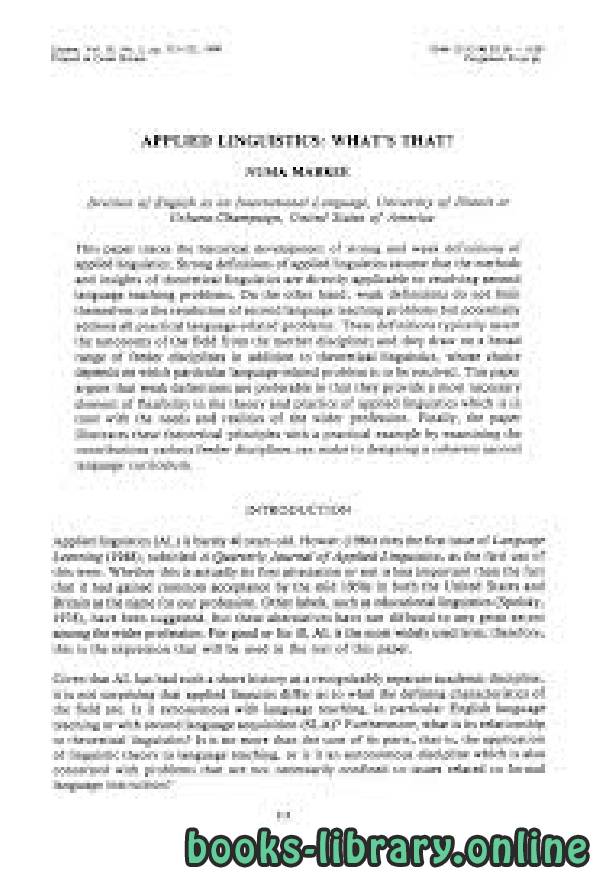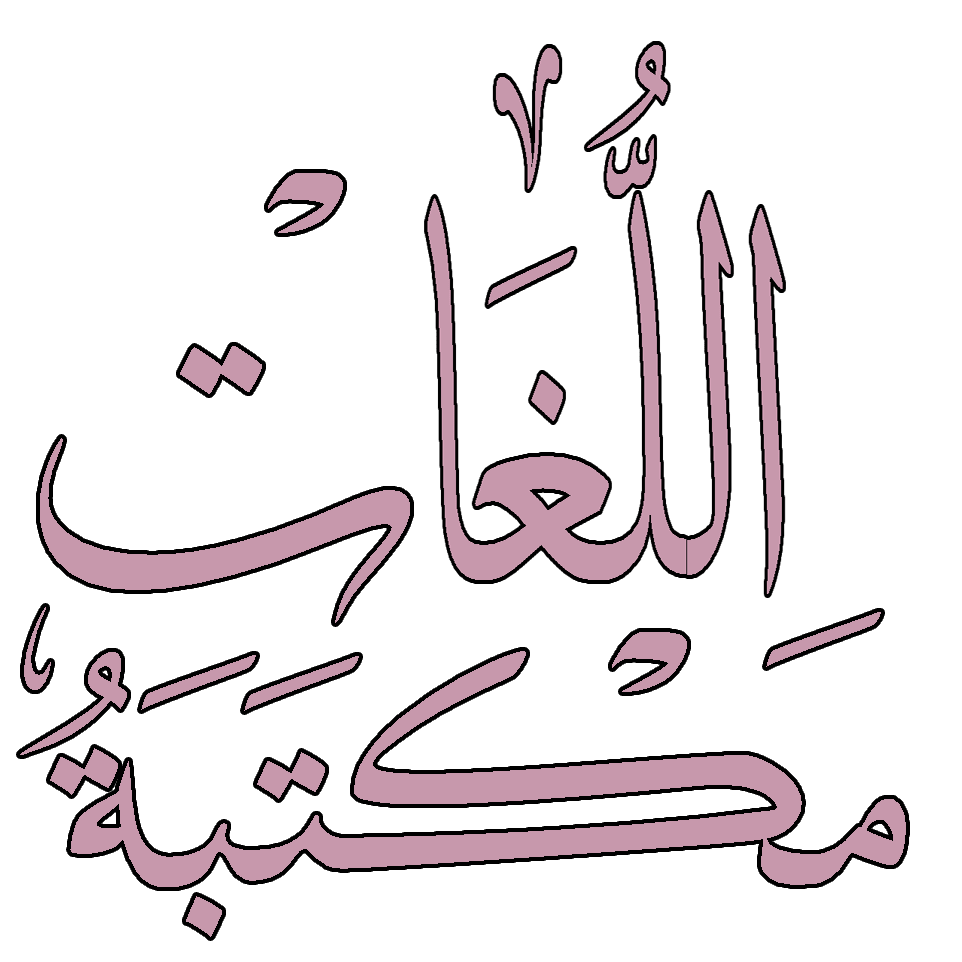كتاب APPLIED LINGUISTICS: WHAT’S THAT? NUMA MARKEE
APPLIED LINGUISTICS: WHAT’S THAT? NUMA MARKEE Division of English as an International Language, University of Illinois at Urbana-Champaign, United States of America This paper traces the historical development of strong and weak definitions of applied linguistics. Strong definitions of applied linguistics assume that the methods and insights of theoretical linguistics are directly applicable to resolving second language teaching problems. On the other hand, weak definitions do not limit themselves to the resolution of second language teaching problems but potentially address all practical language-related problems. These definitions typically assert the autonomy of the field from the mother discipline; and they draw on a broad range of feeder disciplines in addition to theoretical linguistics, whose choice depends on which particular language-related problem is to be resolved. This paper argues that weak definitions are preferable in that they provide a most necessary element of flexibility in the theory and practice of applied linguistics which is in tune with the needs and realities of the wider profession. Finally, the paper illustrates these theoretical principles with a practical example by examining the contributions various feeder disciplines can make to designing a coherent second language curriculum. INTRODUCTION Applied linguistics (AL) is barely 40 years old. Howatt (1984) cites the first issue of Language Learning (1948), subtitled A Quarterly Journal of Applied Linguistics, as the first use of this term. Whether this is actually its first attestation or not is less important than the fact that it had gained common acceptance by the mid 1950s in both the United States and Britain as the name for our profession. Other labels, such as educational linguistics (Spolsky, 1978), have been suggested, but these alternatives have not diffused to any great extent among the wider profession. For good or for ill, AL is the most widely used term; therefore, this is the expression that will be used in the rest of this paper. Given that AL has had such a short history as a recognizably separate academic discipline, it is not surprising that applied linguists differ as to what the defining characteristics of the field are. Is it synonymous with language teaching, in particular English language teaching or with second language acquisition (SLA)? Furthermore, what is its relationship to theoretical linguistics? Is it no more than the sum of its parts, that is, the application of linguistic theory to language teaching, or is it an autonomous discipline which is also concerned with problems that are not necessarily confined to issues related to formal language instruction?Numa Markee - ❰ له مجموعة من الإنجازات والمؤلفات أبرزها ❞ APPLIED LINGUISTICS: WHAT’S THAT? NUMA MARKEE ❝ ❱
من اللغويات التطبيقية Applied linguistics كتب تعلم اللغة الإنجليزية - مكتبة كتب تعلم اللغات.

قراءة كتاب APPLIED LINGUISTICS: WHAT’S THAT? NUMA MARKEE أونلاين
معلومات عن كتاب APPLIED LINGUISTICS: WHAT’S THAT? NUMA MARKEE:
APPLIED LINGUISTICS: WHAT’S THAT?
NUMA MARKEE
Division of English as an International Language, University of Illinois at
Urbana-Champaign, United States of America
This paper traces the historical development of strong and weak definitions of
applied linguistics. Strong definitions of applied linguistics assume that the methods
and insights of theoretical linguistics are directly applicable to resolving second
language teaching problems. On the other hand, weak definitions do not limit
themselves to the resolution of second language teaching problems but potentially
address all practical language-related problems. These definitions typically assert
the autonomy of the field from the mother discipline; and they draw on a broad
range of feeder disciplines in addition to theoretical linguistics, whose choice
depends on which particular language-related problem is to be resolved. This paper
argues that weak definitions are preferable in that they provide a most necessary
element of flexibility in the theory and practice of applied linguistics which is in
tune with the needs and realities of the wider profession. Finally, the paper
illustrates these theoretical principles with a practical example by examining the
contributions various feeder disciplines can make to designing a coherent second
language curriculum.
INTRODUCTION
Applied linguistics (AL) is barely 40 years old. Howatt (1984) cites the first issue of Language
Learning (1948), subtitled A Quarterly Journal of Applied Linguistics, as the first use of
this term. Whether this is actually its first attestation or not is less important than the fact
that it had gained common acceptance by the mid 1950s in both the United States and
Britain as the name for our profession. Other labels, such as educational linguistics (Spolsky,
1978), have been suggested, but these alternatives have not diffused to any great extent
among the wider profession. For good or for ill, AL is the most widely used term; therefore,
this is the expression that will be used in the rest of this paper.
Given that AL has had such a short history as a recognizably separate academic discipline,
it is not surprising that applied linguists differ as to what the defining characteristics of
the field are. Is it synonymous with language teaching, in particular English language
teaching or with second language acquisition (SLA)? Furthermore, what is its relationship
to theoretical linguistics? Is it no more than the sum of its parts, that is, the application
of linguistic theory to language teaching, or is it an autonomous discipline which is also
concerned with problems that are not necessarily confined to issues related to formal
language instruction?
سنة النشر : 1990م / 1410هـ .
عدد مرات التحميل : 5873 مرّة / مرات.
تم اضافته في : الثلاثاء , 31 ديسمبر 2019م.
حجم الكتاب عند التحميل : 0.7MB .
تعليقات ومناقشات حول الكتاب:
هذا القسم يحتوي علي مصادر خاصة بعلم الأصوات.
هو فرعٌ من فروع اللسانيات "أي علم اللغة"، وهذا الفرعُ يعنى بتطبيق النظريات اللغوية ومعالجة المشكلات المتعلقة باكتساب اللغة الأولى والثانية وتعليمها. كما يعنى هذا الحقل بالتحليل التقابلي بين اللغات للاستفادة منه في تحسين ظروف تعلم اللغات وتدريسها. تأثر هذا الحقل من اللسانيات بنظريات العالم اللغوي الأمريكي المعروف "ناعوم تشومسكي"، وخاصة نظرية النحو الكلي "Universal Grammar" والتي تفسر قدرة الإنسان على اكتساب أي لغة بشرية بغض النظر عن عرقه أو لونه أو معتقده أو ديانته، ومن ثم محاولة توظيف هذه النظرية في سبيل الوصول إلى فهم أكثر لعملية الاكتساب اللغوي. ويعد عقد التسعينيات من القرن العشرين هو عقد ازدهار حقل اللسانيات التطبيقية، حيث أصبح بعض الشيء حقلاً مستقلاً عن اللسانيات النظرية "Theoretical Linguistics" وأصبحت العديد من الجامعات تقدم برامج للدراسات العليا المتخصصة باللسانيات التطبيقية كما أصبح هناك العديد من المراكز والمنظمات التي تعنى بهذا الحقل كالجمعية الأمريكية للسانيات التطبيقية، ومركز اللسانيات التطبيقية بالولايات المتحدة وغيرها من المنظمات بأمريكا والمملكة المتحدة.
حقل اللسانيات التطبيقية يتقاطع مع فروع أخرى للمعرفة ومن هذه الفروع بالإضافة إلى اللسانيات، هناك علم الإنسان "Anthropology" وعلم النفس "Psychology" والتربية والتعليم "Education" وكذلك علم الإدراك "The Cognitive Science" ويحاول توظيف كل ما تنتجه فروع المعرفة هذه لصالح تعلم اللغات واكتسابها بين البشر.
Applied linguistics is an interdisciplinary field which identifies, investigates, and offers solutions to language-related real-life problems. Some of the academic fields related to applied linguistics are education, psychology, communication research, anthropology, and sociology.
contents
1 Domain
2 Journals
3 History
4 Associations
4.1 Australia
4.2 Canada
4.3 Ireland
4.4 Japan
4.5 New Zealand
4.6 South Africa
4.7 United Kingdom
4.8 United States
Domain
Applied linguistics is an interdisciplinary field. Major branches of applied linguistics include bilingualism and multilingualism, conversation analysis, contrastive linguistics, sign linguistics, language assessment, literacies, discourse analysis, language pedagogy, second language acquisition, language planning and policy, interlinguistics, stylistics, language teacher education, pragmatics, forensic linguistics and translation.
Journals
Major journals of the field include Annual Review of Applied Linguistics, Applied Linguistics, Journal of Applied Linguistics, International Review of Applied Linguistics, International Journal of Applied Linguistics, European Journal of Applied Linguistics, Issues in Applied Linguistics, Language Learning, Language and Education, TESOL Quarterly, and Linguistics and Education.
History
The tradition of applied linguistics established itself in part as a response to the narrowing of focus in linguistics with the advent in the late 1950s of generative linguistics, and has always maintained a socially-accountable role, demonstrated by its central interest in language problems.[1]
Although the field of applied linguistics started from Europe and the United States, the field rapidly flourished in the international context.
Applied linguistics first concerned itself with principles and practices on the basis of linguistics. In the early days, applied linguistics was thought as “linguistics-applied” at least from the outside of the field. In the 1960s, however, applied linguistics was expanded to include language assessment, language policy, and second language acquisition. As early as the 1970s, applied linguistics became a problem-driven field rather than theoretical linguistics, including the solution of language-related problems in the real world. By the 1990s, applied linguistics had broadened including critical studies and multilingualism. Research in applied linguistics was shifted to "the theoretical and empirical investigation of real world problems in which language is a central issue."[2]
In the United States, applied linguistics also began narrowly as the application of insights from structural linguistics—first to the teaching of English in schools and subsequently to second and foreign language teaching. The linguistics applied approach to language teaching was promulgated most strenuously by Leonard Bloomfield, who developed the foundation for the Army Specialized Training Program, and by Charles C. Fries, who established the English Language Institute (ELI) at the University of Michigan in 1941. In 1946, Applied linguistics became a recognized field of studies in the aforementioned university.[3] In 1948, the Research Club at Michigan established Language Learning: A Journal of Applied Linguistics, the first journal to bear the term applied linguistics. In the late 1960s, applied linguistics began to establish its own identity as an interdisciplinary field of linguistics concerned with real-world language issues. The new identity was solidified by the creation of the American Association for Applied Linguistics in 1977.
 مهلاً !
مهلاً !قبل تحميل الكتاب .. يجب ان يتوفر لديكم برنامج تشغيل وقراءة ملفات pdf
يمكن تحميلة من هنا 'تحميل البرنامج'

نوع الكتاب : pdf.
اذا اعجبك الكتاب فضلاً اضغط على أعجبني و يمكنك تحميله من هنا:


كتب اخرى في اللغويات التطبيقية Applied linguistics
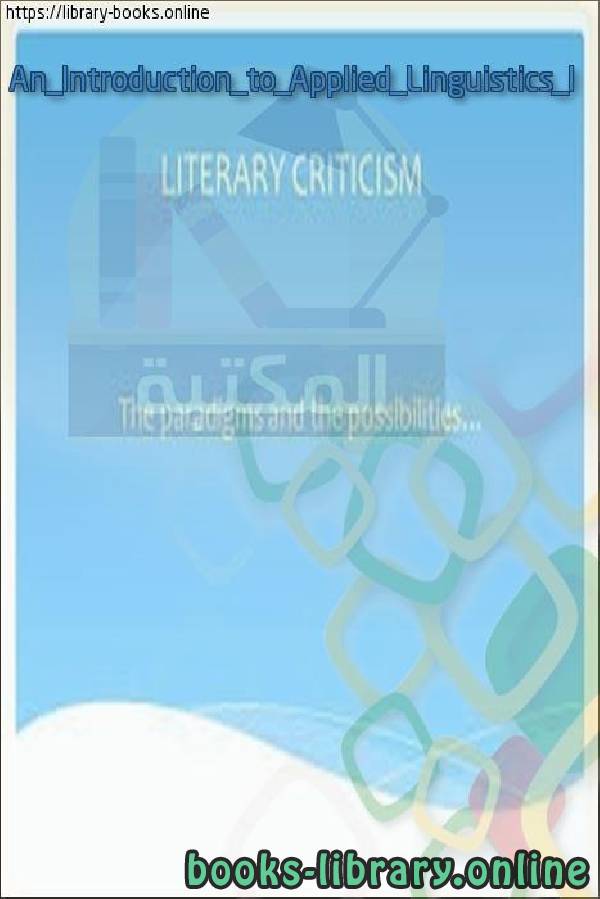
An_Introduction_to_Applied_Linguistics_I PDF
قراءة و تحميل كتاب An_Introduction_to_Applied_Linguistics_I PDF مجانا
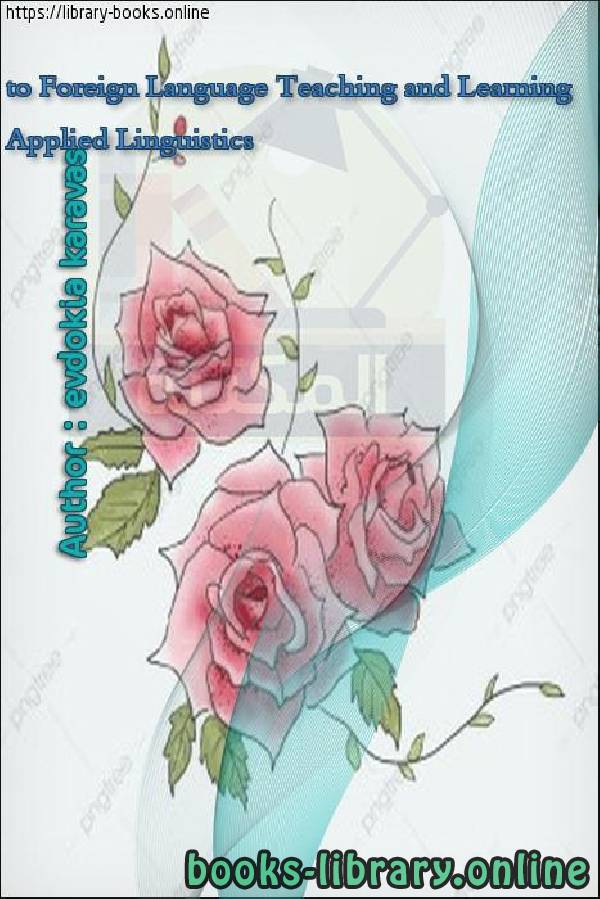
Applied Linguistics to Foreign Language Teaching and Learning : evdokia karavas PDF
قراءة و تحميل كتاب Applied Linguistics to Foreign Language Teaching and Learning : evdokia karavas PDF مجانا
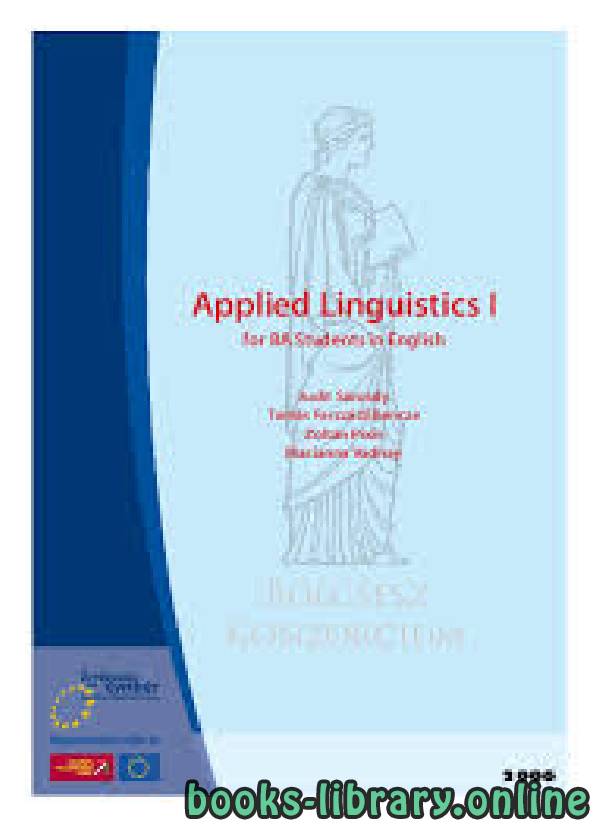
Applied Linguistics I for BA Students in English PDF
قراءة و تحميل كتاب Applied Linguistics I for BA Students in English PDF مجانا
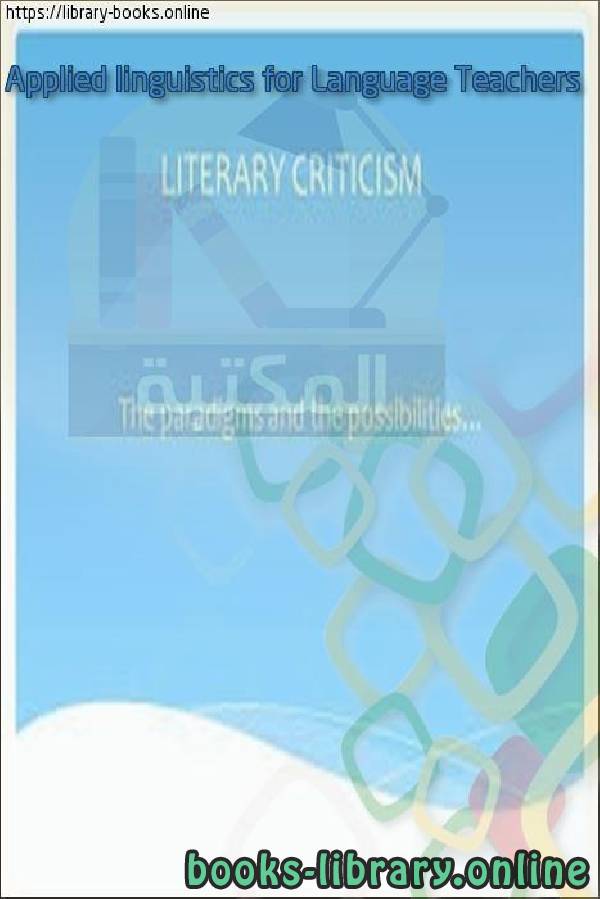
Applied linguistics for Language Teachers PDF
قراءة و تحميل كتاب Applied linguistics for Language Teachers PDF مجانا
